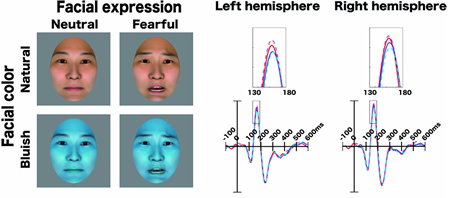
ここからコンテンツです。

Subliminal effect of facial color on fearful faces
Facial color affects N170 stage of subliminal processing of facial expression By Tetsuto Minami
Tetsuto Minami and his colleagues have found that facial color affects the early stage of subliminal processing of facial expressions using ERPs. This provided the first neurophysiological evidence of the effects of facial color on the perception of emotional expressions. This finding may contribute to promoting emotional interaction using avatars in the world of virtual reality.
Facial color is suggestive of emotional states, as in the phrases: “flushed with anger” and “pale with fear.” Although some behavioral studies have investigated the effects of facial color on expression, there was limited neurophysiological evidence showing the effects of facial color on the perception of emotional expressions.
Now, Tetsuto Minami and his colleagues at TUT’s Electronics-Inspired Interdisciplinary Research Institute (EIIRIS), have demonstrated that facial color affects the early stage of subliminal processing of facial expressions using ERPs, which provided the first neurophysiological evidence of the effects of facial color on the perception of emotional expressions. The researchers measured the brain activity from 15 participants during a facial emotion identification task of (1) neutral expressions of natural facial color, (2) fearful expressions of natural facial color, (3) neutral expressions of bluish facial color, and (4) fearful expressions of bluish facial color both in supraliminal and subliminal conditions.

in the subliminal condition
"We have found that the bluish-colored faces increased the N170 latency effect of facial expressions compared to the natural-colored faces, indicating that the bluish color modulated the processing of fearful expressions in the subliminal condition” explains Associate Professor Tetsuto Minami.
The first author Kae Nakajima said "We have been interested in the subliminal effect of facial color since we found the supraliminal effect of facial color using ERPs and fMRI."
As a result, the study has provided new electrophysiological evidence that facial color affects the subliminal processing of fearful expressions. The results showed that the effect of facial color on expression processing was significant in terms of the latency of the N170 only in the subliminal condition, which suggests that facial color has more of an effect on the early stages of expression processing than on the later processing stages.
This finding may contribute to promoting emotional interaction using avatars in the world of virtual reality. The researchers themselves plan to extend their research by making further studies using the natural change of facial color on the perception of facial expressions.
This study was supported by Grants-in-Aid for Scientific Research from the Japan Society for the Promotion of Science (grant number 22300076), the Global COE Program “Frontiers of Intelligent Sensing” from the Ministry of Education, Culture, Sports, Science, and Technology, and the SCOPE from the Ministry of Internal Affairs and Communications, Japan.
Reference
Kae Nakajima, Tetsuto Minami, and Shigeki Nakauchi (2015). Effects of facial color on the subliminal processing of fearful faces, Neuroscience. 310, 472-485. 10.1016/j.neuroscience.2015.09.059
恐怖顔における顔色のサブリミナル効果
顔色は表情のサブリミナル処理におけるN170潜時に影響を与える南哲人准教授らのグループは、脳波の事象関連電位を用いて、顔色が顔表情のサブリミナル処理の早期段階に影響を与えることを発見しました。これは、顔色の効果が感情表情知覚に与える影響を示した最初の神経生理学的証拠といえます。この発見は、バーチャルリアリティにおけるアバターとの感情コミュニケーションの促進への貢献が期待できます。
「真っ赤にして怒る」や「恐怖で真っ青になる」という言葉に表れるように、顔色は感情状態を示します。これまで、いくつかの行動実験研究において、顔色が表情知覚に与える影響が調べられてきましたが、それを示す神経生理学的証拠はありませんでした。
エレクトロニクス先端融合研究所の南哲人准教授らの研究グループは、脳波の事象関連電位を用いることにより、顔色が、顔表情のサブリミナル(閾下)処理の初期段階に影響を与えることを発見しました。これにより、初めて、顔色が表情知覚に与えることを示す神経生理学的証拠が得られたことになります。研究者らは、表情(普通の表情,恐怖表情)と顔色(自然色,青色)の組み合わせからなる4カテゴリの顔表情判定タスク(閾上、閾下条件)中の15人の実験協力者の脳波を測定しました。
実験解析の結果、サブリミナル条件において、青色恐怖顔は、自然色恐怖顔に比べて、N170潜時が遅くなりました。これは、顔色が、サブリミナル条件における恐怖顔の処理を調整していることを示しています。この結果は、顔色が表情知覚に影響を与えるという新しい神経生理学的証拠を示しています。さらに、顔色の効果は、表情処理の早い段階で影響があるということも示唆しています。
これらの結果は、仮想世界におけるアバターとの感情コミュニケーションの促進などの応用が期待できます。研究者らは、今後、自然な顔色変化における顔色の表情知覚への影響を調べていきたいと考えています。
本研究は、科研費22300076、文部科学省グローバルCOEプログラム「インテリジェント・センシングのフロンティア」、および総務省戦略的情報通信研究開発推進制度(SCOPE)の援助により行われました。
Researcher Profile

| Name | Tetsuto Minami |
|---|---|
| Affiliation | Electronics-Inspired Interdisciplinary Research Institute (EIIRIS) |
| Title | Associate Professor |
| Fields of Research | Cognitive Neuroscience |
ここでコンテンツ終わりです。
